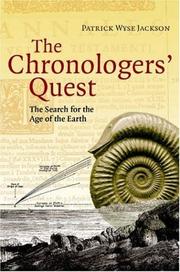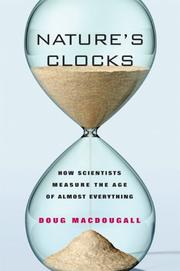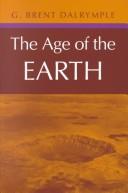| Listing 1 - 10 of 20 | << page >> |
Sort by
|
Book
ISBN: 9535116436 9535150510 Year: 2014 Publisher: IntechOpen
Abstract | Keywords | Export | Availability | Bookmark
 Loading...
Loading...Choose an application
- Reference Manager
- EndNote
- RefWorks (Direct export to RefWorks)
Chronology is the backbone of history, and there is a wise saying stating there is no history without a chronology. Earths evolutionary history is built up by geochronology, i.e. time benchmarks upon which the geological history is built up step by step over its total time period of about 4.5 billion years. The first marker in this history is the Jack Hills zircon from Australia dated at about 4.4 GA. The most detailed records come from seasonal changes within annual varves. Stratigraphy provides the basic chronological ordering of layers by layers, units by units, fossil assemblage by assemblage, varves by varves, growth zone by growth zone, etc. The radiometric techniques implied the introduction of absolute age determinations. This book includes a combination of methodological presentations and related case studies, from where we learn about practical problems and achievements. Therefore, the book should be of basic interest both for scientists in their practical in field and laboratory, as well as for general educational purpose.
Geochronometry. --- Dating of fossils --- Dating of rocks --- Fossils --- Geological chronometry --- Geological time --- Rocks --- Time measurements --- Dating --- Measurement --- Geology & the lithosphere
Book
ISSN: 03058719 ISBN: 9781862393547 1862393540 Year: 2013 Publisher: London : Geological Society,
Abstract | Keywords | Export | Availability | Bookmark
 Loading...
Loading...Choose an application
- Reference Manager
- EndNote
- RefWorks (Direct export to RefWorks)
Magnetostratigraphy is best known as a technique that employs correlation among different stratigraphic sections using the magnetic directions defining geomagnetic polarity reversals as marker horizons. The ages of the polarity reversals provide common tie points among the sections, allowing accurate time correlation. Recently, studies of magnetic methods and the timing of geological processes have acquired a broader meaning, now referring to many types of magnetic measurements within a stratigraphic sequence. Many of these measurements provide correlation and age control not only for the older and younger boundaries of a polarity interval, but also within intervals. Thus, magnetostratigraphy no longer represents a dating tool based only on geomagnetic polarity reversals, but comprises a set of techniques that includes measurements of geomagnetic field parameters, environmental magnetism, rock-magnetic properties, radiometric dating and astronomically forced palaeoclimatic change recorded in sedimentary rocks, and key corrections to magnetic directions related to geodynamics, palaeocurrents, tectonics and diagenetic processes --
Geochronometry. --- Dating of fossils --- Dating of rocks --- Fossils --- Geological chronometry --- Geological time --- Rocks --- Time measurements --- Dating --- Measurement --- Geochronometry
Book
ISBN: 1108893376 1108898009 1108896472 1108789803 Year: 2021 Publisher: Cambridge : Cambridge University Press,
Abstract | Keywords | Export | Availability | Bookmark
 Loading...
Loading...Choose an application
- Reference Manager
- EndNote
- RefWorks (Direct export to RefWorks)
The history of life on earth is largely reconstructed from time-averaged accumulations of fossils. A glimpse at ecologic-time attributes and processes is relatively rare. However, the time-sensitive and predictability of echinoderm disarticulation makes them model organisms to determine post-mortem transportation and allows recognition of ecological-time data within paleocommunity accumulations. Unlike many other fossil groups, this has allowed research on many aspects of echinoderms and their paleocommunities, such as the distribution of soft tissues, assessment of the amount of fossil transportation prior to burial, determination of intraspecific variation, paleocommunity composition, estimation of relative abundance of taxa in paleocommunities, determination of attributes of niche differentiation, etc. Crinoids and echinoids have received the most amount of taphonomic research, and the patterns present in these two groups can be used to develop a more thorough understanding of all echinoderm clades.
Echinodermata, Fossil. --- Geochronometry. --- Dating of fossils --- Dating of rocks --- Fossils --- Geological chronometry --- Geological time --- Rocks --- Time measurements --- Bilateria, Fossil --- Marine invertebrates, Fossil --- Dating --- Measurement

ISBN: 9780521813327 0521813328 9780511617782 9780511242090 0511242093 0511239521 9780511239526 0511247257 9780511247255 0511240457 9780511240454 051124097X 9780511240973 0511241496 9780511241499 1107159032 1280567813 9786610567812 0511318154 051161778X 9781107159037 9781280567810 6610567816 9780511318153 Year: 2006 Publisher: Cambridge Cambridge University Press
Abstract | Keywords | Export | Availability | Bookmark
 Loading...
Loading...Choose an application
- Reference Manager
- EndNote
- RefWorks (Direct export to RefWorks)
The debate over the age of the Earth has been ongoing for over two thousand years, and has pitted physicists and astronomers against biologists, religious philosophers against geologists. The Chronologers' Quest tells the fascinating story of our attempts to determine the age of the Earth. This book investigates the many novel methods used in the search for the Earth's age, from James Ussher and John Lightfoot examining biblical chronologies, Comte de Buffon and Lord Kelvin determining the length of time for the cooling of the Earth, to the more recent investigations of Arthur Holmes and Clair Patterson into radioactive dating of rocks and meteorites. The Chronologers' Quest is a readable account of the measurement of geological time. It will be of great interest to a wide range of readers, from those with little scientific background, to students and scientists in a wide range of the earth sciences.
Geochronometry. --- Geological time. --- Age of rocks --- Geochronology --- Geochrony --- Rocks --- Time, Geological --- Chronology --- Historical geology --- Sequence stratigraphy --- Dating of fossils --- Dating of rocks --- Fossils --- Geological chronometry --- Geological time --- Time measurements --- Age --- Dating --- Measurement

ISBN: 1281752622 1435684737 9786611752620 0520933443 9780520933446 9781435684737 9780520249752 0520249755 9781281752628 6611752625 Year: 2008 Publisher: Berkeley University of California Press
Abstract | Keywords | Export | Availability | Bookmark
 Loading...
Loading...Choose an application
- Reference Manager
- EndNote
- RefWorks (Direct export to RefWorks)
"Radioactivity is like a clock that never needs adjusting," writes Doug Macdougall. "It would be hard to design a more reliable timekeeper." In Nature's Clocks, Macdougall tells how scientists who were seeking to understand the past arrived at the ingenious techniques they now use to determine the age of objects and organisms. By examining radiocarbon (C-14) dating-the best known of these methods-and several other techniques that geologists use to decode the distant past, Macdougall unwraps the last century's advances, explaining how they reveal the age of our fossil ancestors such as "Lucy," the timing of the dinosaurs' extinction, and the precise ages of tiny mineral grains that date from the beginning of the earth's history. In lively and accessible prose, he describes how the science of geochronology has developed and flourished. Relating these advances through the stories of the scientists themselves-James Hutton, William Smith, Arthur Holmes, Ernest Rutherford, Willard Libby, and Clair Patterson-Macdougall shows how they used ingenuity and inspiration to construct one of modern science's most significant accomplishments: a timescale for the earth's evolution and human prehistory.
Geochronometry. --- Geological time. --- Radioisotopes in geology. --- Radioactive isotope geology --- Isotope geology --- Age of rocks --- Geochronology --- Geochrony --- Rocks --- Time, Geological --- Chronology --- Historical geology --- Sequence stratigraphy --- Dating of fossils --- Dating of rocks --- Fossils --- Geological chronometry --- Geological time --- Time measurements --- Age --- Dating --- Measurement
Book
ISBN: 1280126329 9786613530189 0226649393 9780226649399 9781280126321 9780226649375 0226649377 9780226649382 0226649385 Year: 2012 Publisher: Chicago London The University of Chicago Press
Abstract | Keywords | Export | Availability | Bookmark
 Loading...
Loading...Choose an application
- Reference Manager
- EndNote
- RefWorks (Direct export to RefWorks)
Whether the fossil record should be read at face value or whether it presents a distorted view of the history of life is an argument seemingly as old as many fossils themselves. In the late 1700s, Georges Cuvier argued for a literal interpretation, but in the early 1800s, Charles Lyell's gradualist view of the earth's history required a more nuanced interpretation of that same record. To this day, the tension between literal and interpretive readings lies at the heart of paleontological research, influencing the way scientists view extinction patterns and their causes, ecosystem persistence and turnover, and the pattern of morphologic change and mode of speciation. With Stratigraphic Paleobiology, Mark E. Patzkowsky and Steven M. Holland present a critical framework for assessing the fossil record, one based on a modern understanding of the principles of sediment accumulation. Patzkowsky and Holland argue that the distribution of fossil taxa in time and space is controlled not only by processes of ecology, evolution, and environmental change, but also by the stratigraphic processes that govern where and when sediment that might contain fossils is deposited and preserved. The authors explore the exciting possibilities of stratigraphic paleobiology, and along the way demonstrate its great potential to answer some of the most critical questions about the history of life: How and why do environmental niches change over time? What is the tempo and mode of evolutionary change and what processes drive this change? How has the diversity of life changed through time, and what processes control this change? And, finally, what is the tempo and mode of change in ecosystems over time?
Paleontology, Stratigraphic. --- Paleobiology. --- Fossils. --- Paleoecology. --- Geochronometry. --- Dating of fossils --- Dating of rocks --- Fossils --- Geological chronometry --- Geological time --- Rocks --- Time measurements --- Palaeoecology --- Ecology --- Paleobiology --- Paleontology --- Palaeobiology --- Biology --- Stratigraphic paleontology --- Dating --- Measurement
Book
ISBN: 0470347201 9780470347201 Year: 1968 Publisher: London Interscience
Abstract | Keywords | Export | Availability | Bookmark
 Loading...
Loading...Choose an application
- Reference Manager
- EndNote
- RefWorks (Direct export to RefWorks)
Radioactive dating --- Geological time --- Datation radioactive --- Temps géologique --- Geochronometry --- Age determination, Radiometric --- Dating, Radioactive --- Dating, Radiometric --- Fission dating methods --- Radiometric age determination --- Radiometric dating --- Radioactivity --- Dating of fossils --- Dating of rocks --- Fossils --- Geological chronometry --- Rocks --- Time measurements --- Measurement --- Dating --- Geochronometry. --- Radioactive dating. --- Temps géologique --- Geology --- Géologie --- Géochronométrie --- Research --- Recherche --- Datation radioactive. --- Géochronométrie. --- Recherche. --- Hydrosphere --- Geology. Earth sciences --- Géologie --- Géochronométrie.
Periodical
Abstract | Keywords | Export | Availability | Bookmark
 Loading...
Loading...Choose an application
- Reference Manager
- EndNote
- RefWorks (Direct export to RefWorks)
Geology, Stratigraphic --- Paleontology --- Geochronometry --- Stratigraphie --- Paléontologie --- Géochronométrie --- Geochronometry. --- Geology, Stratigraphic. --- Paleontology. --- Quaternary Geologic Period. --- From 2 million years ago --- Fossilogy --- Fossilology --- Palaeontology --- Paleontology, Zoological --- Paleozoology --- Age of rocks --- Rocks --- Stratigraphic geology --- Dating of fossils --- Dating of rocks --- Fossils --- Geological chronometry --- Geological time --- Age --- Dating --- Measurement --- Historical geology --- Zoology --- Prehistoric animals in motion pictures --- Physical geology --- Time measurements --- Dynamic & Structural Geology

ISBN: 0804715696 0804723311 9780804723312 Year: 1991 Publisher: Stanford, Calif. Stanford University Press
Abstract | Keywords | Export | Availability | Bookmark
 Loading...
Loading...Choose an application
- Reference Manager
- EndNote
- RefWorks (Direct export to RefWorks)
Dating of fossils --- Dating of rocks --- Fossils -- Dating --- Geochronometrie --- Geochronometry --- Geological chronometry --- Geological time -- Measurement --- Géochronométrie --- Rocks -- Dating --- Earth --- Age --- 523.31 --- The Earth as an astronomical body --- 523.31 The Earth as an astronomical body --- Géochronométrie --- Geochronometry. --- Earth - Age. --- Earth (Planet) --- Age.
Periodical
ISSN: 18971695 17338387
Abstract | Keywords | Export | Availability | Bookmark
 Loading...
Loading...Choose an application
- Reference Manager
- EndNote
- RefWorks (Direct export to RefWorks)
Geochronometry --- Radioactive dating --- Radiocarbon dating --- Radioactive dating. --- Geochronometry. --- Radiocarbon dating. --- Archaeology --- Carbon dating --- Carbon-14 dating --- Dating, Radiocarbon --- Dating of fossils --- Dating of rocks --- Fossils --- Geological chronometry --- Geological time --- Rocks --- Age determination, Radiometric --- Dating, Radioactive --- Dating, Radiometric --- Fission dating methods --- Radiometric age determination --- Radiometric dating --- Dating --- Measurement --- Archaeological dating --- Time measurements --- Radioactivity
| Listing 1 - 10 of 20 | << page >> |
Sort by
|

 Search
Search Feedback
Feedback About UniCat
About UniCat  Help
Help News
News